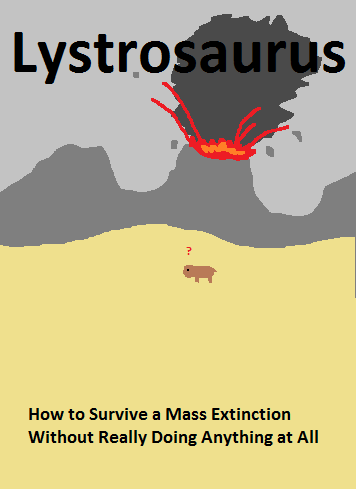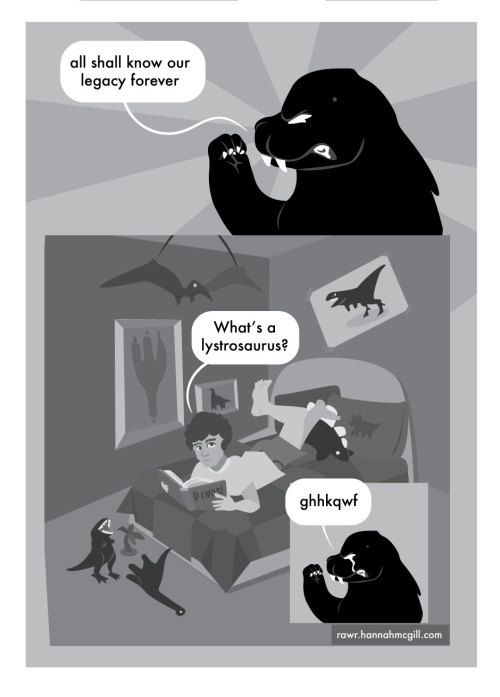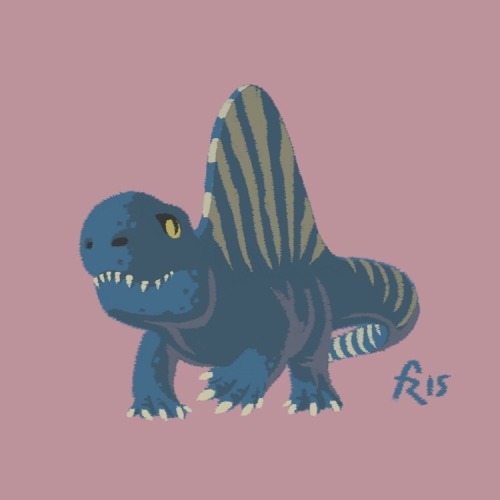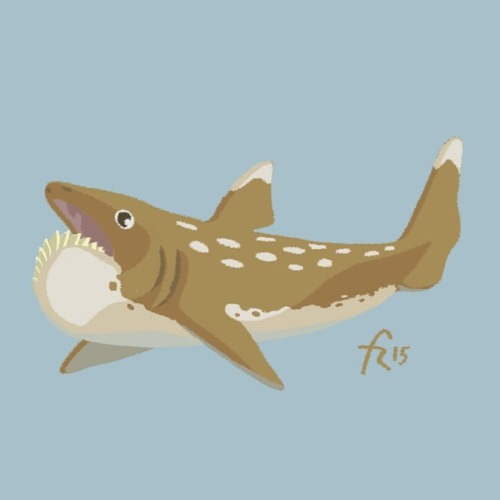#lystrosaurus

Survive unisex t-shirt
At first I was afraid, I was petrified…
If Lystrosaurus survived the greatest mass extinction event on Earth, you can probably make it through the week!
sulc.us/survive
Design by David Orr
Ornithosuchus, Richard Orr,
The sound of Ornithosuchus eating is revolting, a tearing, tugging, smacking, slurping, gulping, dripping allegro backed by the hum of blood-drinking insects. A lystrosaur should deserve a better eulogy.
Post link
Lystrosaurus – Late Permian-Early Triassic (255-250 Ma)
I’m back! I was sort of at a loss of what animal to talk about when I came back from my hiatus in earnest, but during the spotty downtime I had last week, I read When Life Nearly Died by Michael Benton, and that pointed me in the direction of this chubby little gentleman, whose name is Lystrosaurus.Lystrosaurus is one of the (very very VERY) few animals to survive the Permian-Triassic Extinction event, and we’re gonna take a look at why exactly that is.
Lystrosaurus is yet another synapsid, or proto-mammal. This guy was a member of the second wave of Paleozoic synapsid radiation, a member of the order Therapsida, which were characterized by being more similar to true mammals than the first group, the pelycosaurs. EdaphosaurusandCotylorhynchuswere both pelycosaurs, and were a bit more basal. Lystrosaurus shows a few of those therapsid traits, most importantly the shape of its skull and its semi-sprawling gait. On the less mammalian side of things, it probably had a beak made of horn for shearing vegetation. It had the characteristic deep body cavity for digesting all the tough plants it ate. It also had no teeth except for a pair of enlarged canines, which it probably used to uproot its food. The most common species was about the size of a schnauzer, although a much rarer species grew a bit larger. All-in-all, it wasn’t really anything special compared to its contemporaries.
Despite being tiny and rather typical of an animal from its time period, Lystrosaurus is an important animal for a few reasons. Even though plate tectonics are common knowledge and accepted as fact now, it took a long time for it to gain any serious traction. Alfred Wegener was pretty much laughed off when he first suggested the continents move in 1915. As a part of this theory, Wegener also suggested the continents had been united at some point into a supercontinent he called Pangea. His contemporaries heard the idea and basically said, “Okay but continents don’t move, obviously. Have you ever seen a continent move?” To their credit, the evidence at the time was, more or less, Africa and South America fitting together and other such things. Which, yeah, we know were right now, but back then it wasn’t so obvious. The next several decades were a slow march to acceptance of the theory of continental drift. Lystrosaurus figures into this by having been found in Asia, Africa, Europe, and even Antarctica by the 70s. At that point, even the most hardened skeptics shrugged and said, “Okay, yeah, fine.”
Lystrosaurus is known from an absolutely stupid number of fossils. The Great Karoo Basin in South Africa has an unreasonable amount of Lystrosaurus remains. They make up 95% of the animals found there, and they’re so abundant that paleontologists pull their hair out trying to find literally anything else. The most studied parts of the Karoo Basin span the late Permian and Early Triassic, and once you get into the Triassic rocks, it’s pretty much Lystrosaurus all the way down. Why is that?
Because nothing else survived the Permian Extinction.
There are five major mass extinctions in the Phanerozoic Eon. I’ve talked about two of them on this blog so far. I talked about the End-Ordovician extinction event when I covered Endoceras, and the End-Triassic extinction with Effigia. And I’m here to say that those events were fucking peanuts compared to this one. This was the single greatest crisis for life on earth, to the point that it’s often called The Great Dying. This was the destruction of about 90% of all species on earth at the time, and for a while we weren’t even really sure what was causing everything to fucking die. The most accepted theory nowadays is the series of eruptions of the Siberian Traps at the end of the Permian period. Basically, most of what we now call Siberia turned into a volcanic wasteland and exploded every so often, anywhere from every few thousand years to every few months.
These were more than volcanic eruptions. This was fire and brimstone, magma punching massive holes in the earth and launching toxic gasses and solid ejecta into the atmosphere. Anything remotely nearby suffocated or was struck by fiery debris. This wasn’t the most severe killing agent, though, not at all. The Great Dying earned its name because of the secondary effects. The gasses spewing into the atmosphere blocked out the sun and caused flash-freezing, followed by periods of global warming. Glaciers melted and released even more toxic gasses trapped beneath them, poisoning the seas and killing anything unadapted to anoxic conditions. It’s pretty telling that the majority of the marine animals that survived into the early Triassic were clearly adapted to life without plentiful oxygen. Plants on land were suffocated or frozen to death, and the ecosystems collapsed from there. The earth was a frigid, barren landscape. The seas and land alike would be littered with corpses of animals and plants. The earth has mechanisms to balance these influxes of toxic chemicals, but the problem was that by the time those mechanisms could get started, Siberia would erupt again and start the process all over again. If you were to walk around Pangea during the peak of this crisis, 1) It would fucking suck, and 2) You’d probably come across a very distressed Lystrosaurus before finding any other animal.
Why in the goddamn hell did Lystrosaurus survive when so many other animals didn’t? It’s a complicated question, because it’s important to ask another question first: What animals are vulnerable to extinction events? There are a couple of broad categories of vulnerable animals during mass extinctions:
Large animals: Large animals are especially vulnerable because they need more energy to keep themselves going, and almost always have small populations and slow reproductive cycles. This goes for predator and prey alike. When plants start dying, herbivores can’t feed themselves, and the large carnivores that prey on them don’t have anything substantial to eat. This is the reason animals like elephants and rhinos have such a hard time bouncing back after we nearly hunted them all to extinction.
Specialized animals:Specialized animals are almost always doomed in big extinctions. If an animal is really, really good at functioning in a specific environment, it’s going to bite it as soon as that environment gets thrown off-kilter. Animals that specialize in eating a specific plant or hunting in a specific environment don’t usually survive when everything gets hit.
So, the animals who are most likely to survive a mass extinction are the small generalists, who can thrive pretty much anywhere. Lystrosaurus fits this description, but forget all of that for the purpose of this conversation, because the Great Dying decimated life of all sorts. Generalists were more or less just as likely to die off as the specialized animals or the big guys. So, we ask again, why did Lystrosaurus survive when so many other animals, even those similar to it, didn’t?
There isn’t really an answer to that question. Scientists have puzzled over the remains of Lystrosaurus and asked over and over again, “Why this little bastard?” and they’ve come up with nothing substantial. It was luck that a little beaked herbivore was one of the lucky few. There’s no adaptation that made it particularly hardy in the face of total metazoan annihilation. There’s no reason it survived the act break between the Paleozoic and Mesozoic eras. It just did because it happened to survive. This isn’t a parable of survival as much as it is one of dumb luck. One of the characteristics of a mass extinction is that it is essentially indiscriminate. Lystrosaurus had every reason to perish like its relatives, but it just didn’t. Being the generalist that it was, it wasn’t hard for it to recover when the Siberian Traps died down and life finally gained a foothold. It multiplied at an absurd rate and covered the earth. The early Triassic was unequivocally dominated by waddling herds of Lystrosaurus. An argument could be made that it’s the single most successful genus of synapsid in history, although MusandRattus would probably argue that point.
Whew. That was a lot. I hope it serves as a fitting return! Lystrosaurus was an animal I’d been meaning to cover for a long time, but only now felt like I was able to do it any justice. There’s so much to say about Lystrosaurus, to the point I could write a book about it. The cover would probably look something like this:

I’ll see you next time!
******************************************************************************
Buy me a Coffee, if you’d like!
Post link













